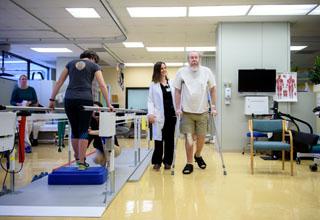Benefits of Mobility Aids: When Is It Time for a Walker, Cane or Wheelchair?

As parents, watching our children take their first steps is one of the proudest, most gratifying moments imaginable. As adult children, watching our parents begin to lose their footing is one of the most concerning. Those who find themselves at this juncture are often left wondering what to do and where to turn for more information.
To help with this dilemma, we’ve asked Timothy Parke, Rehab Clinical Supervisor at Orchard Cove and a Board Certified Specialist in geriatric physical therapy to answer some fundamental questions about assistive devices.
Can you briefly explain the different types of mobility aids available and their primary function?
TP: Assistive devices range from canes, which offer the least support, to walkers, which have 4 points of support, making them more stable than canes. There are many different types of wheelchairs designed to meet an individual’s level of activity and mobility. Scooters, or powered wheelchairs, are a good option if self-propelling is not possible.
What are the different reasons that a person might need a mobility aid?
TP: Often a device can allow a person to walk further with less fatigue or pain. If you realize that walking in a store with a carriage is much easier than walking without, then a cane or a walker might be helpful.
If you’ve experienced “close calls” where you have almost fallen, then a device might be a part of the solution. The device should be considered only one part of a more comprehensive plan, however. Often balance, strength, and gait stability impairments can also be improved with a prescription of specific exercises and activities.
Which mobility aids are best for which symptoms?
TP: Working with a physical therapist will be the surest way to match the need with the best device to manage it. Sometimes a person needs to explore the options with a PT to learn what makes sense. There is a learning curve when beginning to use an assistive device. It’s a good idea to take the time to learn the correct ways to use a new device by getting training from a PT or other health professional.
Where might a person have a balance assessment done and what does it entail?
TP: A balance screen at your primary care provider’s office can alert him or her to any concerns about gait and balance that might be improved with an assistive device. Your PCP can make a referral for a full physical therapy evaluation if indicated.
What is the approximate cost for various mobility aids? Are they covered by insurance or Medicare?
TP: Medicare covers 80% of an assistive device if prescribed by primary care provider. Often Medigap insurance covers the other 20%. Replacements are covered after waiting 5 years.
Can a person with a mobility aid still exercise?
TP: Ideally, a mobility aid should allow a person to be as active as possible. For many people who become fatigued or have pain while walking without a device, using a cane or walker can often allow them to walk further. This results in the positive outcome of an overall increase in activity.
Any advice for adult children on initiating the conversation about mobility aids with an unwilling parent?
TP: A device can be used strategically. It does not always need to be used all of the time, rather it can be tailored for particular needs. Knowing this can give your parent some control over the use of the device.
While simply getting from point A to point B may be the most basic purpose of an assistive device, it can actually be a tool to improve one’s quality of life. The decision to use an assistive device should allow an older adult to be as active as they safely can be and participate in the full spectrum of life’s activities.
Blog Topics
Learn More
Outpatient Rehabilitative Therapies
At Hebrew Rehabilitation Center in Boston and Dedham, MA, we offer adult physical therapy, occupational therapy, and speech therapy using state-of-the-art mobility and treatment equipment.




